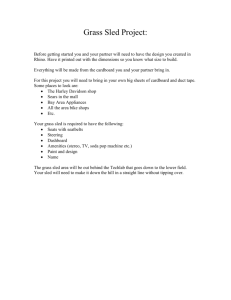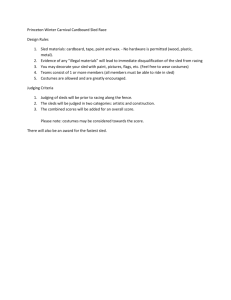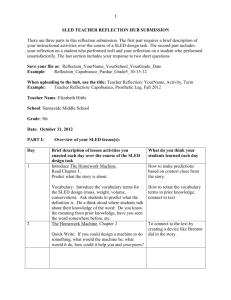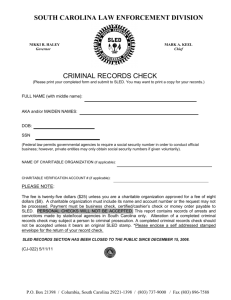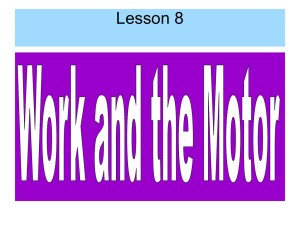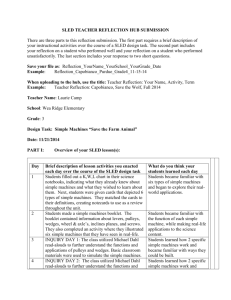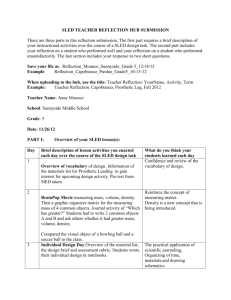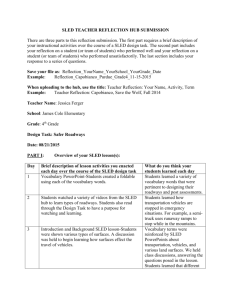Document
advertisement
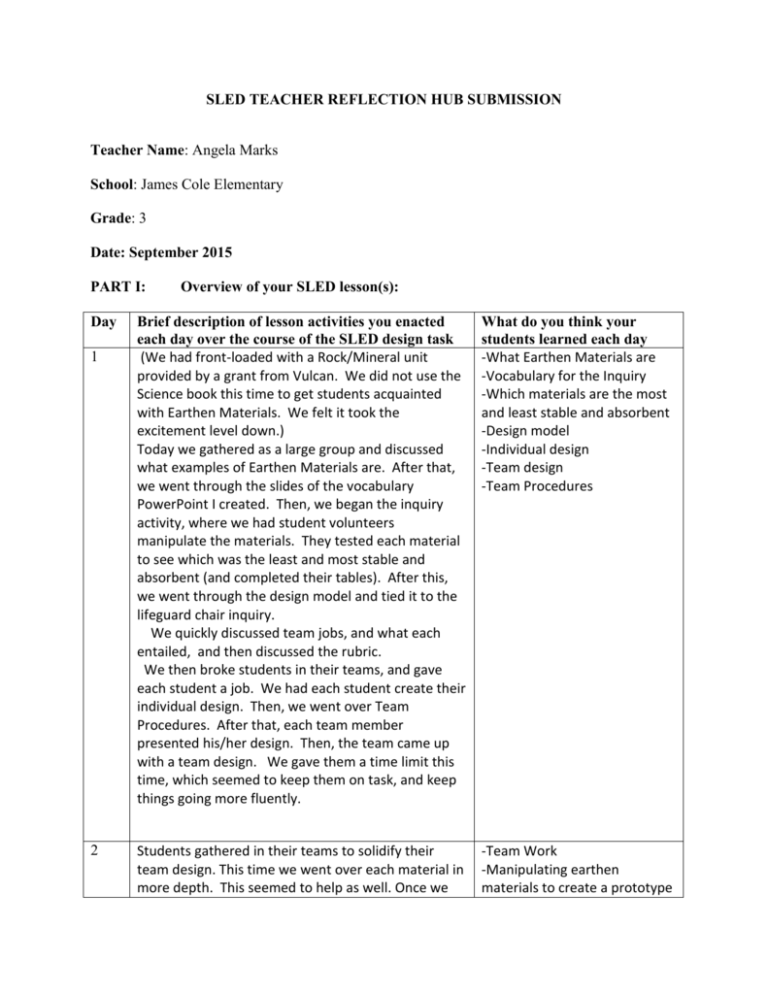
SLED TEACHER REFLECTION HUB SUBMISSION Teacher Name: Angela Marks School: James Cole Elementary Grade: 3 Date: September 2015 PART I: Day 1 2 Overview of your SLED lesson(s): Brief description of lesson activities you enacted each day over the course of the SLED design task (We had front-loaded with a Rock/Mineral unit provided by a grant from Vulcan. We did not use the Science book this time to get students acquainted with Earthen Materials. We felt it took the excitement level down.) Today we gathered as a large group and discussed what examples of Earthen Materials are. After that, we went through the slides of the vocabulary PowerPoint I created. Then, we began the inquiry activity, where we had student volunteers manipulate the materials. They tested each material to see which was the least and most stable and absorbent (and completed their tables). After this, we went through the design model and tied it to the lifeguard chair inquiry. We quickly discussed team jobs, and what each entailed, and then discussed the rubric. We then broke students in their teams, and gave each student a job. We had each student create their individual design. Then, we went over Team Procedures. After that, each team member presented his/her design. Then, the team came up with a team design. We gave them a time limit this time, which seemed to keep them on task, and keep things going more fluently. What do you think your students learned each day -What Earthen Materials are -Vocabulary for the Inquiry -Which materials are the most and least stable and absorbent -Design model -Individual design -Team design -Team Procedures Students gathered in their teams to solidify their team design. This time we went over each material in more depth. This seemed to help as well. Once we -Team Work -Manipulating earthen materials to create a prototype 2 3 were finished, they gathered materials, and created their prototype. The teams needed one more day so we gave them time. Today they finished fabrication, and we tested the prototypes. Students determined if their Earthen Dam was successful. If it was not, they made an individual team re-design. -Test a prototype -Redesign Please answer the questions below: 1. What worked well? -The large group inquiry -Learning the vocabulary -Creating the prototype -Extending the time limit a day helped. 2. What are two ways you can improve your efforts toward integrating design? -We think that breaking the entire task into even more days will help. 3 PART II: Reflection#1 on student performance: Include an image of work from one student who you thought performed well on the task. Insert the image here within the Word document. This image may be a copy of the student’s notebook entry(s) or an image of the team’s artifact or an actual picture of the student at work. In the space below describe what the image(s) is about and why you would explain or characterize the student’s performance as mastery or excellent. 1) This student was familiar with and knew exactly what the Inquiry and Design Model entailed. 2) This student drew and labeled, in detail, the individual plan. 3) This student took the designs of many, and with the team came up with one design. This showed that the student knew how to accept peers’ work, and sketch the team design. 4 Reflection#2 on student performance: Include an image of work from one student who you thought did not perform as well (unsatisfactory) on the task. Insert the image here within the Word document. This image may be a copy of the student’s notebook entry(s) or an image of the team’s artifact or an actual picture of the student at work. In the space below describe what the image is about and why you would explain or characterize the student’s performance as unsatisfactory. -I don’t believe this child understand what labeling meant. This student also did not use much effort. There is very little detail, and very little labeling. Although he could explain what was in his mind, it wasn’t on the paper. 5 PART II: Reflection #3 Describe one thing you enjoyed about instructing this SLED task. -This SLED unit is a blast! It was so helpful to have done this once already. Adding all of the “tweaks” really helped it run more smoothly, and gave the students more time. I always love the hands on parts of the lesson. They enjoy getting “down and dirty”. As always, the “did it work” portion is always a blast! Describe one thing in your practice you would improve upon next time you implement this engineering design task or another SLED design task. -We will break the task into even more days. We think they just need shorter spurts of time, as their attention level, even with hands on activities, is minimal this time of year. PART III: Reflection Questions: Please answer each of the questions below. 1. Based on your students’ presentation of their work, what features made a good design? A good design features detailed drawings, much labeling, and overall clarity of what is in the design. 2. What features made a poor design? A poor design features bare minimum drawings, very little or no labeling, and overall poor details. 3. Which phases of the engineering design process do you feel most comfortable and confident in teaching? Of all the phases of the design process, I feel confident in teaching the redesign. This is a difficult phase, but I believe the most thought provoking and rewarding. 6 4. Which phases of the engineering design process do you feel least comfortable and confident in teaching? Of all the phases of the design process, I feel the least confident in teaching individual design. There are times I feel the students are “lost” and I want to give them ideas. I realize I cannot do this, which is difficult. 5. What is one area in your implementation of the design tasks you want to improve upon in your next implementation? I will improve upon explaining the materials for the design task. I felt the students did not have enough real world knowledge of the materials, therefore they refrained from using some of them. 6. Do you feel you teach science differently now than you did years ago? If so, how are you teaching science differently? What do you think caused you to change your practice? If not, why do you think you have not changed? I am diligently THINKING about HOW I am teaching science. I am creating small design tasks and allowing the students to solve them ON THEIR OWN. Their problem solving skills are sky-rocketing! I owe all of the above to SLED and its partners. SLED gave me the vision for my students to ENJOY thinking! 7. Is there anything that causes you concern, that you are afraid of when you think about changing your science teaching and implementing SLED design tasks? Are there things that keep you from changing your teaching? The only thing that has been a setback is the funds for materials. Other than that, I am forever grateful for being allowed to participate in SLED.
